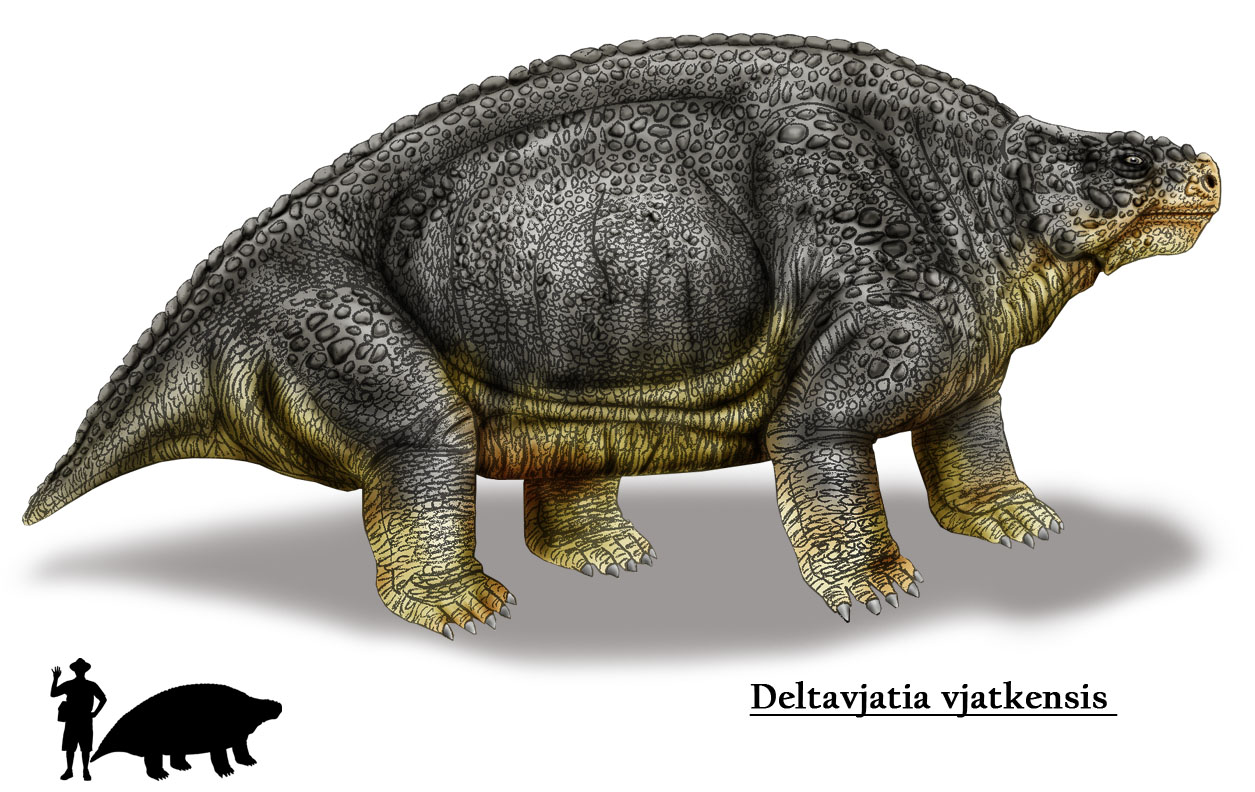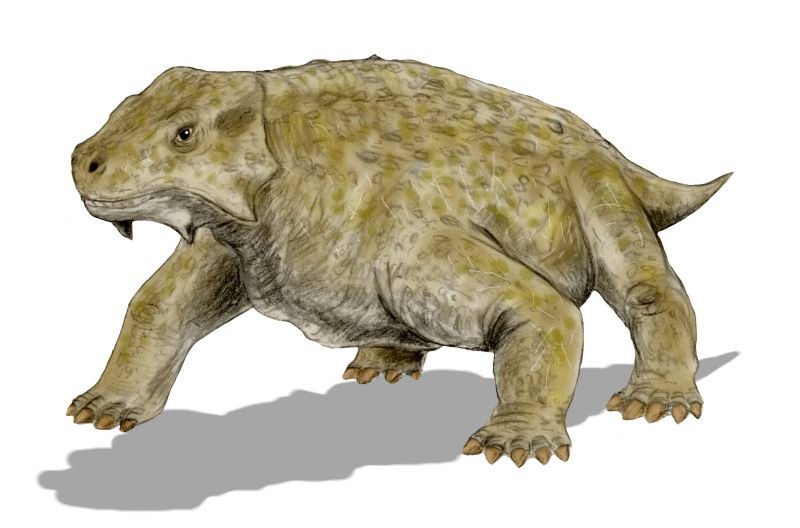|
Deltavjatia Vjatkensis
''Deltavjatia'' was a pareiasauromorph procolophonoid from the Tatarian stage of the Permian time period. It had a large body of about in length. ''Deltavjatia'' was an herbivore and lived in what is now Russia. The first specimen of ''Deltavjatia'' was a specimen of a skull and lower mandible (PIN 2212/1), found in the Urpalov Formation in Kotelnich, Vyatka River. Since then, numerous mostly complete skeletons have been found, many of them being so well preserved due to the silty, anaerobic environment of the Kotelnich deposits that fossilised white blood cells are able to be distinguished in them. Analyses of the bone histology of ''Deltavjatia'' show that they grew very rapidly during the early stages of their ontogeny but that their growth rate drastically slowed down once they reached approximately half of their full body size. ''Deltavjatia'' was placed as a subtaxon of Pareiasauridae by M.S.Y. Lee in 1997. See also *Pareiasaur *Procolophonia The Procolophonia ... [...More Info...] [...Related Items...] OR: [Wikipedia] [Google] [Baidu] |
Capitanian
In the geologic timescale, the Capitanian is an age or stage of the Permian. It is also the uppermost or latest of three subdivisions of the Guadalupian Epoch or Series. The Capitanian lasted between and million years ago. It was preceded by the Wordian and followed by the Wuchiapingian.; 2004: ''A Geologic Time Scale 2004'', Cambridge University Press A significant mass extinction event occurred at the end of this stage, which was associated with anoxia and acidification in the oceans and possibly caused by the volcanic eruptions that produced the Emeishan Traps. This extinction event may be related to the much larger Permian–Triassic extinction event that followed about 10 million years later. Stratigraphy The Capitanian Stage was introduced into scientific literature by George Burr Richardson in 1904. The name comes from the Capitan Reef in the Guadalupe Mountains (Texas, United States). The Capitanian was first used as a stratigraphic subdivision of the Guadalupian in 1 ... [...More Info...] [...Related Items...] OR: [Wikipedia] [Google] [Baidu] |
Kotelnich
Kotelnich (russian: Коте́льнич; chm, Кäкшäр) is a river port town in Kirov Oblast, Russia, located on the right bank of the Vyatka River near its confluence with the Moloma, along the route of the Trans-Siberian Railway, southwest of Kirov. Population: History The locality of Koksharov () was first mentioned in 1143 as a Mari town. In 1182, it was occupied by Russians and renamed Kotelnich, from the word ''kotel'' (now ''kotlovina''), meaning "hollow", "depression".Е. М. Поспелов. "Географические названия мира". Москва, 1998, p. 218. Town status was granted to it in 1780. It became one of the main settlements of the Vyatka Land. The city of Kotelnich is well known all over Russia and in some foreign countries due to location of ancient fossil vertebrates – Pareiasaurus. Pareiasaurus – is a large reptile with spurs in the buccal region of the skull. These animals grew to about 3 meters long and inhabited Eur ... [...More Info...] [...Related Items...] OR: [Wikipedia] [Google] [Baidu] |
Extinct Animals Of Russia
Extinction is the termination of a kind of organism or of a group of kinds (taxon), usually a species. The moment of extinction is generally considered to be the death of the Endling, last individual of the species, although the Functional extinction, capacity to breed and recover may have been lost before this point. Because a species' potential Range (biology), range may be very large, determining this moment is difficult, and is usually done retrospectively. This difficulty leads to phenomena such as Lazarus taxon, Lazarus taxa, where a species presumed extinct abruptly "reappears" (typically in the Fossil, fossil record) after a period of apparent absence. More than 99% of all species that ever Life, lived on Earth, amounting to over five billion species, are estimated to have died out. It is estimated that there are currently around 8.7 million species of eukaryote globally, and possibly many times more if microorganisms, like bacteria, are included. Notable extinct a ... [...More Info...] [...Related Items...] OR: [Wikipedia] [Google] [Baidu] |
Permian Reptiles
The Permian ( ) is a geologic period and stratigraphic system which spans 47 million years from the end of the Carboniferous Period million years ago (Mya), to the beginning of the Triassic Period 251.9 Mya. It is the last period of the Paleozoic Era; the following Triassic Period belongs to the Mesozoic Era. The concept of the Permian was introduced in 1841 by geologist Sir Roderick Murchison, who named it after the region of Perm in Russia. The Permian witnessed the diversification of the two groups of amniotes, the synapsids and the sauropsids (reptiles). The world at the time was dominated by the supercontinent Pangaea, which had formed due to the collision of Euramerica and Gondwana during the Carboniferous. Pangaea was surrounded by the superocean Panthalassa. The Carboniferous rainforest collapse left behind vast regions of desert within the continental interior. Amniotes, which could better cope with these drier conditions, rose to dominance in place of their amphibian ... [...More Info...] [...Related Items...] OR: [Wikipedia] [Google] [Baidu] |
Pareiasaurs
Pareiasaurs (meaning "cheek lizards") are an extinct clade of large, herbivorous parareptiles. Members of the group were armoured with scutes which covered large areas of the body. They first appeared in southern Pangea during the Middle Permian, before becoming globally distributed during the Late Permian. Pareiasaurs were the largest reptiles of the Permian, reaching sizes equivalent to those of contemporary therapsids. Pareiasaurs became extinct at the end of the Permian during the Permian-Triassic extinction event. Description Pareiasaurs ranged in size from long, and may have weighed up to . They were stocky, with short tails, small heads, robust limbs, and broad feet. The cow-sized species ''Bunostegos'', which lived 260 million years ago, is the earliest known example of a tetrapod with a fully erect posture as its legs were positioned directly under its body. Pareiasaurs were protected by bony scutes called osteoderms that were set into the skin. Their heavy skulls were ... [...More Info...] [...Related Items...] OR: [Wikipedia] [Google] [Baidu] |
Vyatka (river)
The Vyatka (; rus, Вя́тка, p=ˈvʲatkə; tt-Cyrl, Нократ, translit=Noqrat; chm, Виче, Viče; udm, Ватка, Vatka) is a river in Kirov Oblast and the Republic of Tatarstan in Russia, a right tributary of the Kama. It is long, and its covers .«Река Вятка» Russian State Water Registry ... [...More Info...] [...Related Items...] OR: [Wikipedia] [Google] [Baidu] |
Procolophonia
The Procolophonia are a suborder of herbivorous reptiles that lived from the Middle Permian till the end of the Triassic period. They were originally included as a suborder of the Cotylosauria (later renamed Captorhinida Carroll 1988) but are now considered a clade of Parareptilia. They are closely related to other generally lizard-like Permian reptiles such as the Millerettidae, Bolosauridae, Acleistorhinidae, and Lanthanosuchidae, all of which are included under the Anapsida or "Parareptiles" (as opposed to the Eureptilia). Classification There are two main groups of Procolophonia, the small, lizard-like Procolophonoidea, and the Pareiasauroidea, which include the large, armoured Pareiasauridae. According to the traditional classification of Carroll 1988 as well as recent phylogenetic analyses, smaller groups like Rhipaeosauridae (now a synonym of Nycteroleteridae) and Sclerosauridae are classified with the pareiasaurs and with the procolophonids, respectively. T ... [...More Info...] [...Related Items...] OR: [Wikipedia] [Google] [Baidu] |
Pareiasaur
Pareiasaurs (meaning "cheek lizards") are an extinct clade of large, herbivorous parareptiles. Members of the group were armoured with scutes which covered large areas of the body. They first appeared in southern Pangea during the Middle Permian, before becoming globally distributed during the Late Permian. Pareiasaurs were the largest reptiles of the Permian, reaching sizes equivalent to those of contemporary therapsids. Pareiasaurs became extinct at the end of the Permian during the Permian-Triassic extinction event. Description Pareiasaurs ranged in size from long, and may have weighed up to . They were stocky, with short tails, small heads, robust limbs, and broad feet. The cow-sized species '' Bunostegos'', which lived 260 million years ago, is the earliest known example of a tetrapod with a fully erect posture as its legs were positioned directly under its body. Pareiasaurs were protected by bony scutes called osteoderms that were set into the skin. Their heavy skulls wer ... [...More Info...] [...Related Items...] OR: [Wikipedia] [Google] [Baidu] |
Subtaxon
In biology, a taxon (back-formation from ''taxonomy''; plural taxa) is a group of one or more populations of an organism or organisms seen by taxonomists to form a unit. Although neither is required, a taxon is usually known by a particular name and given a particular ranking, especially if and when it is accepted or becomes established. It is very common, however, for taxonomists to remain at odds over what belongs to a taxon and the criteria used for inclusion. If a taxon is given a formal scientific name, its use is then governed by one of the nomenclature codes specifying which scientific name is correct for a particular grouping. Initial attempts at classifying and ordering organisms (plants and animals) were set forth in Carl Linnaeus's system in ''Systema Naturae'', 10th edition (1758), as well as an unpublished work by Bernard and Antoine Laurent de Jussieu. The idea of a unit-based system of biological classification was first made widely available in 1805 in the intro ... [...More Info...] [...Related Items...] OR: [Wikipedia] [Google] [Baidu] |
Deltavjatia Vjatkensis
''Deltavjatia'' was a pareiasauromorph procolophonoid from the Tatarian stage of the Permian time period. It had a large body of about in length. ''Deltavjatia'' was an herbivore and lived in what is now Russia. The first specimen of ''Deltavjatia'' was a specimen of a skull and lower mandible (PIN 2212/1), found in the Urpalov Formation in Kotelnich, Vyatka River. Since then, numerous mostly complete skeletons have been found, many of them being so well preserved due to the silty, anaerobic environment of the Kotelnich deposits that fossilised white blood cells are able to be distinguished in them. Analyses of the bone histology of ''Deltavjatia'' show that they grew very rapidly during the early stages of their ontogeny but that their growth rate drastically slowed down once they reached approximately half of their full body size. ''Deltavjatia'' was placed as a subtaxon of Pareiasauridae by M.S.Y. Lee in 1997. See also *Pareiasaur *Procolophonia The Procolophonia ... [...More Info...] [...Related Items...] OR: [Wikipedia] [Google] [Baidu] |
Vyatka River
The Vyatka (; rus, Вя́тка, p=ˈvʲatkə; tt-Cyrl, Нократ, translit=Noqrat; chm, Виче, Viče; udm, Ватка, Vatka) is a river in Kirov Oblast and the Republic of Tatarstan in Russia, a right tributary of the Kama. It is long, and its covers .«Река Вятка» Russian State Water Registry ... [...More Info...] [...Related Items...] OR: [Wikipedia] [Google] [Baidu] |
Mandible
In anatomy, the mandible, lower jaw or jawbone is the largest, strongest and lowest bone in the human facial skeleton. It forms the lower jaw and holds the lower tooth, teeth in place. The mandible sits beneath the maxilla. It is the only movable bone of the skull (discounting the ossicles of the middle ear). It is connected to the temporal bones by the temporomandibular joints. The bone is formed prenatal development, in the fetus from a fusion of the left and right mandibular prominences, and the point where these sides join, the mandibular symphysis, is still visible as a faint ridge in the midline. Like other symphyses in the body, this is a midline articulation where the bones are joined by fibrocartilage, but this articulation fuses together in early childhood.Illustrated Anatomy of the Head and Neck, Fehrenbach and Herring, Elsevier, 2012, p. 59 The word "mandible" derives from the Latin word ''mandibula'', "jawbone" (literally "one used for chewing"), from ''wikt:mandere ... [...More Info...] [...Related Items...] OR: [Wikipedia] [Google] [Baidu] |

.jpg)



